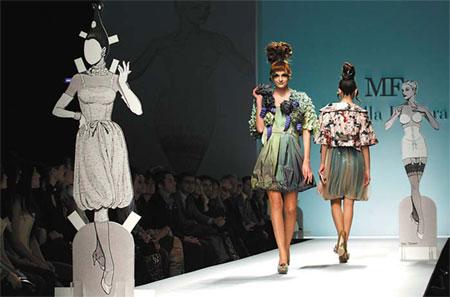
Models display creations by Italian designer Marella Ferrera during a Rome Fashion Week Haute Couture Spring/Summer 2009 show on Sunday.
Free designer dresses, an army of admirers and $15,000 to stroll down a catwalk: no wonder thousands of teenage girls aspire to be a top model.
But at the haute couture shows in Paris, the leggy blondes in silk dresses who advertise a life of luxury are finding their world turned inside out by the economic crisis.
"Half-price! It's half-price everywhere, in Milan, even in New York," cried Anna Chyzh, a 23-year-old from Kiev who had just changed out of a Stephane Rolland haute couture gown into jeans and was headed to the next show.
Like many models from Ukraine, Russia and the Balkans, Chyzh regularly sends money home to support her mother, a freelance interior designer who is having trouble finding work because of the downturn.
"She says, Anna, you have to help me now. So we have to work for Mom, we cannot refuse any contracts now," she added before disappearing in a swarm of equally blonde and skinny girls.
Shunned by scrimping shoppers amid rising unemployment and fears of a long, deep recession, retailers across the board have cut profit forecasts and marketing budgets.
Even larger luxury goods groups are feeling the pain. Richemont, the Swiss firm behind Montblanc pens and Cartier watches, announced earlier this year it saw no signs of a recovery after third-quarter sales missed forecasts.
Magazine publishers from Conde Nast, which owns Vogue, to Time Inc are seeing advertising sales dive, and the New York Times has said it expects sales to deteriorate further.
At the January fashion shows in Paris and Milan, a prime advertising opportunity for luxury brands, designers hired fewer models than last year. Models and agents are feeling the pinch.
At Premier Model Management in London, an agency that has represented Claudia Schiffer, clients who used to pay a daily rate of 3,000 pounds ($4,200) are now arriving with a budget of 1,500 pounds, director Aidan Jean-Marie said.
To weather the crisis, agencies are adjusting their mix of so-called "commercial models", who attract a steady stream of low-key jobs such as catalogue shoots, and pricier "image models" who appear on catwalks and magazine covers.
"You need both sides to survive the downturn, but the balance shifts slightly towards the commercial models," said Jean-Marie. "The catwalk girls are not your day-to-day girls, they are anomalies, with measurements they had when they were 16 and still have at 18."
Karen Diamond, director at Models 1, the agency of supermodel Agyness Deyn, expects the full impact of the crisis to hit later this year since advertising budgets and show schedules are planned far in advance.
"Clients will go with established models rather than giving new faces a break, and it'll be tough for new girls," she said.





